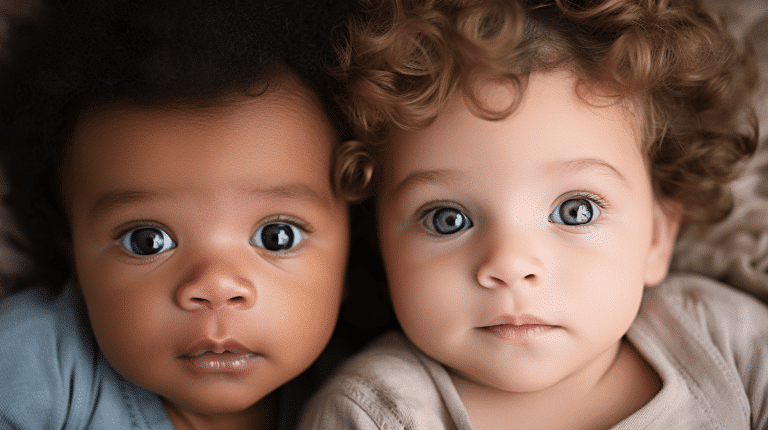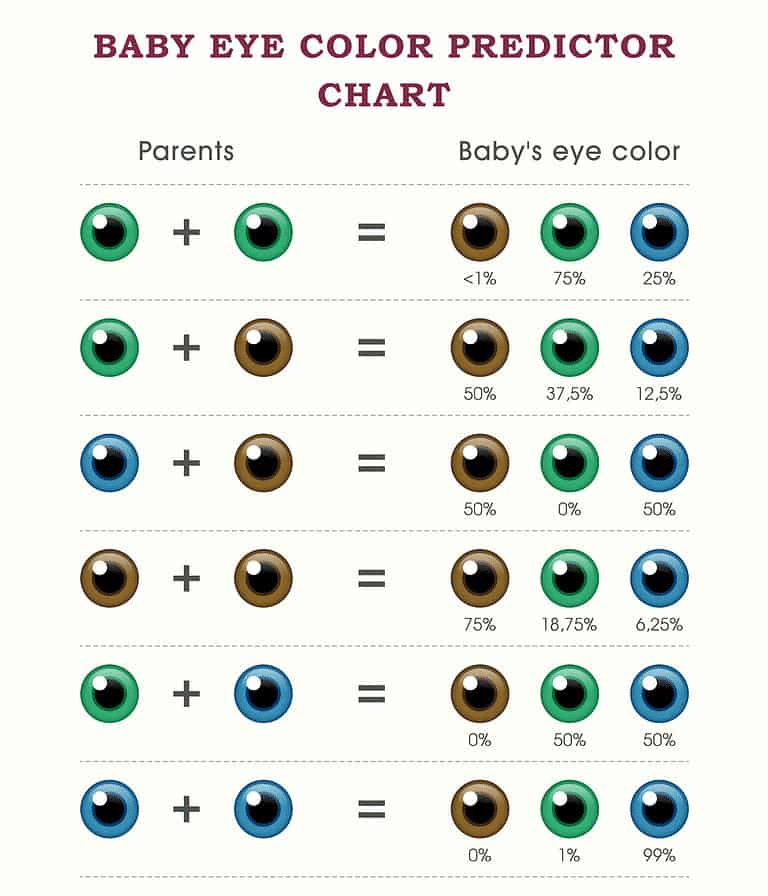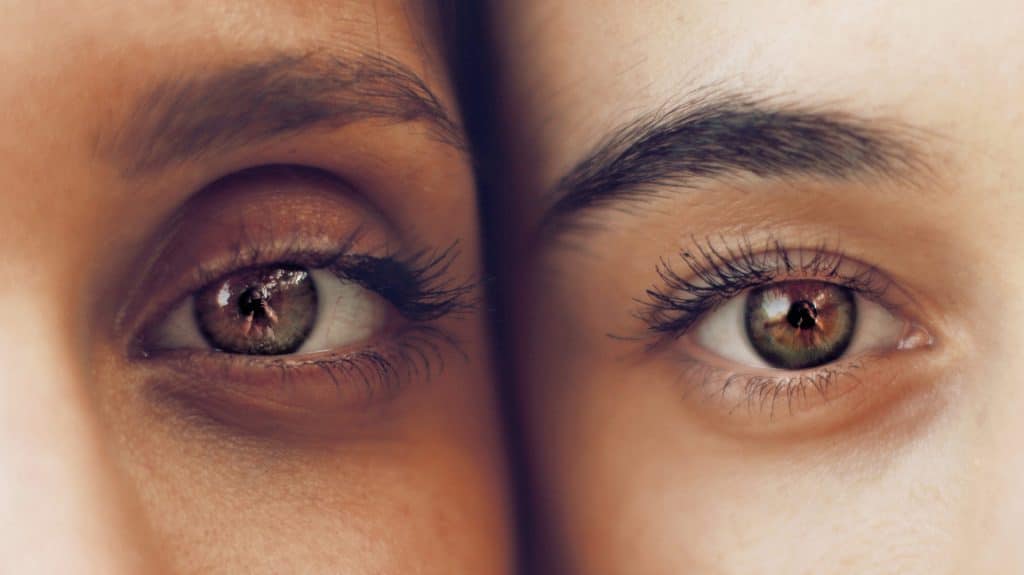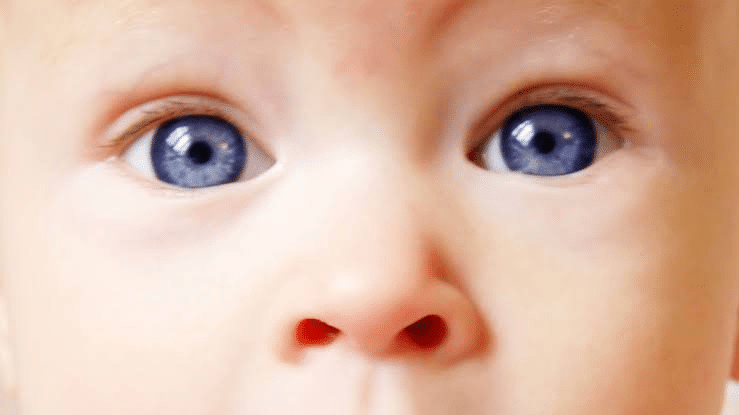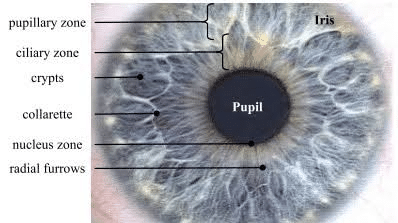Are you expecting the baby to pop up anytime soon now? And you cannot stop wondering what he or she looks like. If you are expecting a baby, it is very natural to think about how your baby will look and what kind of hair, skin, or eyes your baby will have.
Especially in the last few months, the anticipation and curiosity have been really strong. There are several questions in the mind of parents-to-be, and one most common one is, whose eye color baby will inherit- mothers or fathers?
Well, there is no definite answer to any of your questions, but the good news is you can get a hint of what color eyes your newborn baby will have when he or she is born with the help of this eye color chart.
What is an Eye Colour Chart?
Eye color refers to the color of the iris, which differs from baby to baby. Eye color highly depends on the genes the baby inherits from its parents. So, it is quite impossible to know with total certainty which color eyes the baby will have, but there are ways to make some fair predictions. An eye color chart helps predict the color of the eye of the baby based on the parent’s eye colors.
As the baby inherits 50% of eye color genetic material from both parents, the eye color of the baby can be calculated from the eye color of the parents. This is a simple grid chart where the eye color of both parents is entered in two columns, and based on it, the probability of the child having blue, green, or brown eyes is provided.
Here, you will see different combinations of eye sets of parents of brown, blue, and green colors on the left side and the probabilities of a baby having a specific eye color on the right.
Interpretation of Baby Eye Colour Chart
- If both parents have blue eyes, there is a 99% chance that the baby will be born with blue eyes.
- If both parents have brown eyes, there is a 75% chance that the baby will have brown eyes as well, with a possibility of 18% of the baby having blue eyes.
- When both parents have green eyes, there is a 75% chance of the baby having green eyes but a good 25% chance of the baby being born with blue eyes.
- When one parent has green and the other has blue eyes, the probability divides you 50-50% for each. In such a case, which gene among the inherited ones dominates will decide the color of the eyes.
- There is the same situation as above when one parent has blue eyes and the other has brown; there are equal chances of a baby having any of these two eye colors.
- Though, it’s not the same when a parent has green eyes, and another has brown. As brown is a dominant color, the chances of a baby having brown eyes are 50, and the rest divides between green and blue.
Limitations of Baby Eye Colour Chart
- This eye color chart does not take into consideration different eye colors other than brown, green, and blue. Each DNA is unique and can form shades of colors.
- It does not accurately work in cases of complex inheritance. For example, according to this baby eye color chart, two blue eyes parents cannot have a brown eye child; however, if one of the parents inherits the genes of a brown eye parent of their own, it is still a possibility that the baby inherits brown eyes.
- Hazel eye color is still a mystery that cannot be solved with the help of this chart as this shade is a mixture of brown, green, and blue color.
How are Eye Colours Formed?
Eye color is formed by a combination of pigments produced in the layers of the iris; each layer is called a stroma. There are majorly three types of pigmentations.
- Melanin– It is a yellow-brown pigment that is also responsible for determining skin tone in babies.
- Pheomelanin– It is a red-orange pigmentation that is responsible for red hairs in humans. This pigment is found in people with green and hazel eyes.
- Eumelanin– This pigment decides how intense the color will be. It is a black-brown pigment that is found in dark-colored eyes.
The combination of these pigments decides the shade of the eyes. It can fall anywhere on the spectrum of dark to light. The eye color of a newborn is related to the skin tone. White babies tend to be born with blue or grey eyes because of less melanin, and black, Asian, or Hispanic babies have black or dark brown eyes. So now you know what plays a role in that baby blue or dreamy brown eyes!
Here are some fun eye color facts:
- Between 55% to 75% of the total people in the world have brown eyes.
- Only 8 to 10% of people have blue eyes.
- Very surprisingly, only 2% of the total world population have green eyes, making it the rarest eye color.
How Does Genetics Determine Eye Colour?
Not only does parents’ eye color matter in determining the color of a baby’s eyes, but also if parents are homozygous or heterozygous dominant for a specific eye color and if the parent’s genes are dominant or recessive. Let’s understand this in detail.
1. Homozygous and Heterozygous
Every human takes birth with two copies of each gene, one from the mother and the other from the father. When these two copies of each gene match or are very similar, it is called Homozygous. It dominates that particular trait in the newborn ( eye color in this case). And when the two copies are different from each other, it is recessive and is called Heterozygous. The genes inherited by a child can be dominant genes or recessive genes.
Which Leads to Two Types of Eye Colour
Dominant Eye Colour
Brown and Green are the dominant eye color. This means that If the eye color of both the parents is the same, either brown or green, there is a 75 to 90% chance that the baby will be born with the same eye color as the parents.
Recessive Eye Colour
Blue is a recessive eye color. This means that the chances of a baby having a different eye color from the parents are very low. Your baby won’t have blue eye color if you and your partner both have brown eyes.
2. Genotype
Genotype is a combination of genes in DNA that are responsible for each unique trait and characteristic of a human. There is a different genotype for each trait, like height, skin, color, and eyes. In this case, the father’s and mother’s genotypes will decide the eye color of their children.
3. Phenotype
Genotype defines Phenotype; it is a visible trait like hair color, blood type, height, or eye color. It is a result of the kind of genotype a human has.
Taking Care of Your Baby’s Eyes
No matter what color, those delicate and beautiful baby eyes require the best possible care. Take extra precautions in the first few months after the birth of the baby to keep his or her eyes clean and safe. It is normal if you notice a little discharge from your newborn eyes for the first few months. Clean it gently while bathing the baby, do not wash or wipe the eyes all the time with a tissue or a washcloth.
Secondly, do not give sharp toys or objects to the baby to play with because newborn babies have zero muscle control. If a sharp object hurts those little eyes, the damage is irreversible. Lastly, pay close attention to your baby’s eye alignment; some squinting or misalignment is normal in the initial months, but if that persists after 6 months of age, consult a pediatrician.
What Eye Colour Says About Baby’s Personality
It may sound surprising to you, but yes, some extended studies and research have related colors and patterns of the eyes with personality traits. The color of the eye, patterns of the crypts, which are detailed treads that surrounds the pupil, and the contraction furrows, which are the lines that curve the outer edge of the human eye, can predict a person’s character. This is because the genes which are accountable for the development of the iris in a baby also play a role in shaping the frontal lobe of the brain, which forms a person’s personality. Here are a few derivations of what psychology studies say.
- People with dark-colored eyes are more pleasant and compliant.
- People with extremely dark eyes are good at target-hitting sports like archery or darts.
- People with densely packed crypts are more warm-hearted and tender and can be trusted.
- Mothers with light-colored eyes tolerate pain and stress better. It is also seen that light-eyed mothers tolerate pain pretty well during childbirth.
- People with more contraction furrows are more impulsive and are more likely to give in to cravings.
Various research and advanced studies are going on every day to know more about the formation of color in infants’ eyes and what it says about their personalities.
Conclusion
In short, predicting your child’s eye color with help from this eye color chart is a fun way to keep the guessing game on, but not definite. You may or may not want your child to have a specific eye color, but there is nothing much you can do to decide the eye color of a child other than contribute to your genes.
We understand your curiosity and excitement to know everything about your unborn baby but trust us; there is no way you can comprehend your tiny miracle by mere calculations.
No matter what color eyes your baby will have, there will be nothing more surreal than the feeling of looking into those when you finally hold your newborn in your arms!
Frequently Asked Questions
Are Eye Color Charts and Calculators Always Right?
No, there are various limitations to this eye color chart or any calculator you may find online. Eye color is formed by not a single gene but by a set of different genes, and no calculations can tell what genes your baby will inherit exactly.
Can a Baby Have Two Eyes of Different Colors?
It is not normal when the baby is born with two different colors of irises; this condition is called heterochromia. It usually has no side effects, but in some cases, it may lead to trauma or a medical condition called Horner’s Syndrome or Waardenburg syndrome. It is recommended to consult a pediatrician or an ophthalmologist if your baby has different-colored eyes.
Can the Color of Your Baby’s Eye Change After Birth?
Yes, the color of your newborn baby’s eye changes noticeably during their first few months, and they only get a permanent color once they are a year old. The eyes generally turn into darker shades because of the increase in melanin synthesis. It will not happen at once but rather gradually.
Can the Color of a Baby’s Eye Change from Brown to Blue After Birth?
No, if your baby has blue eyes at birth, they may eventually turn brown or hazel because eye color usually shifts from light to dark and not otherwise. So if your kid is born with brown eyes, it is very unlikely that it will turn blue, and you can do nothing about it.
Can Both Blue-Eyed Parents Have a Brown-Eyed Child?
Yes, it is possible. If both the parents have blue eyes, but one of the four grandparents has brown eyes, it is a possibility that the trait is passed down in genes to the baby.
Are Blue Eyes More Sensitive to Light?
When eyes are very sensitive to sunlight or fluorescent lights, the condition is called photophobia. Usually, this is caused in people with Light-colored eyes because they have a very low amount of pigmentation in the layers of their eyes.

